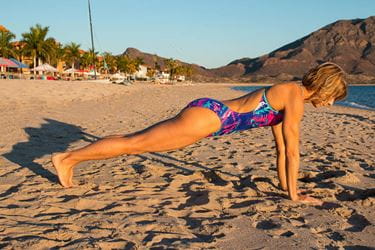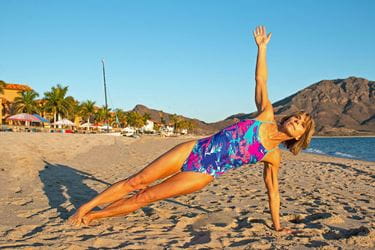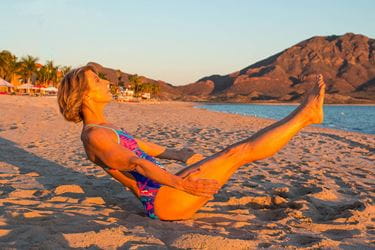Three Yoga Poses for Functional Core Strength
A strong core is important for swimming fast
The core muscles are in the pelvic region and torso and include the spinal and abdominal muscles. A strong core enables an athlete to perform spinal flexion and twisting activities with minimal trauma on the skeletal system. The core also serves as the power center for the body. Movements performed by an athlete with a strong and stable core have more power and require less effort. For this reason, solid core strength is critical for excelling in any sport, including swimming.
Many yoga postures, or asanas, strengthen core muscles. Breath, or pranayama, is the most vital component of yoga and should always lead the way when moving into and sustaining each posture. Breathe long and slow and smooth, feeling expansion in the abdomen, rib cage, and chest. Notice the subtleties of the breath. Taking deep breaths will help you become more aware of breath quality and how proper alignment facilitates longer, more restorative breathing.
The plank, side plank, and boat pose all support a healthy core. For best results, perform these asanas after a series of sun salutations or a bout of aerobic activity so your muscles are warm and more flexible. The “no pain, no gain” philosophy should be discarded when practicing yoga. A burn in the working muscles is normal, but no pain should be felt in the shoulder or lower back.
Plank (Phalakasana)
Benefits
The plank improves stability of your shoulder girdle and strengthens your abdominal, spinal, shoulder, chest, and upper arm muscles. It’s considered a functional core-strengthening exercise because it requires so many muscles to work at once. The plank calls on your abdominal (rectus abdominis and transverse abdominis) and spinal muscles in your core while also requiring assistance from muscles in your shoulder girdle and upper arms.
upper arm muscles. It’s considered a functional core-strengthening exercise because it requires so many muscles to work at once. The plank calls on your abdominal (rectus abdominis and transverse abdominis) and spinal muscles in your core while also requiring assistance from muscles in your shoulder girdle and upper arms.
The weight-bearing action of the plank strengthens your shoulder girdle. The load borne by these muscles will lead to improved stability of your shoulder joint so that it can do more with less potential for injury. Your shoulder joint needs a proper balance of strength to keep the head of your humerus (the bone in your upper arm) properly aligned in the glenohumeral joint socket. Having good balance between the muscles in the front and back of your shoulders leads to healthier shoulders.
How to Execute
Start on your hands and knees. Place your hands directly under your shoulders and extend one and then your other foot back, toes curled under, positioning your torso parallel to the floor. Avoid locking your elbows and keep your head in alignment with your spine, gazing down toward your mat. Open your collarbones and pull your shoulders down and away from your ears to engage your scapular muscles and release any tension present in your neck. If you have wrist problems or carpal tunnel syndrome, you can modify this pose by supporting yourself on your forearms, rather than your hands. To make the asana more challenging, you can try raising one leg.
Hold the pose for 10 to 20 long, slow breaths. When your muscles start to fatigue, concentrate on your breathing so that it remains continuous. A long slow breath will also distract you from the sensation of fatigue.
Side Plank (Vasisthasana)
Benefits
The side plank is another excellent core- and shoulder-strengthening exercise for swimmers. It strengthens the muscles in your shoulder girdle as well as the glutes, inner thigh muscles, and all of your abdominal muscles. It requires excellent shoulder stability in order to balance.
your abdominal muscles. It requires excellent shoulder stability in order to balance.
How to Execute
Lay on your side on your mat or transition to this pose from a regular plank. Place the hand (or elbow, for modified side plank, which is more appropriate if you have wrist issues) you want to be on bottom slightly in front of your corresponding shoulder and either stack your top ankle over your bottom ankle or place the inside of your top foot on the floor in front of your bottom foot, which will be behind your top foot with the outside of the foot on the mat. Keep your top hand on the floor in front of you while you position your body in side plank and establish balance. Raise your hips so that your body is in a long, diagonal line from your foot to the crown of your head. Firm your scapula and pull your shoulders down and away from your ears. Avoid sagging in your hips and rib cage. Spread your fingers and keep your weight evenly distributed throughout your bottom hand. Reach your top hand up toward the ceiling once you feel balanced. Hold the pose for 10 to 20 long, slow breaths and focus on continuing to breathe even after you start to feel fatigued. Transition to the other side and then repeat.
If you’re having difficulty staying balanced, even with the staggered leg option, the side plank can be practiced with the back of your body against a wall. Avoid this asana if you have had a recent shoulder injury or are experiencing chronic shoulder discomfort.
Boat Pose (Paripurna Navasana)
Benefits
Boat pose is an excellent core-muscle and hip-flexor strengthener. Your hip flexors, rectus abdominis, and transverse abdominis help you raise and keep your legs up off the floor. Your oblique abdominals and upper postural muscles assist with balancing and maintaining optimal postural alignment in this asana. Paripurna navasana also alleviates stress, improves digestion, and stimulates the kidneys, thyroid gland, and intestines.
abdominals and upper postural muscles assist with balancing and maintaining optimal postural alignment in this asana. Paripurna navasana also alleviates stress, improves digestion, and stimulates the kidneys, thyroid gland, and intestines.
How to Execute
Start by sitting on your mat with your legs extended. Place your hands on the floor a couple of inches behind your hips. Bend your knees and place your feet flat on the floor. Elevate your torso from the crown of your head, imagining a string attached to your head is lengthening your entire spine. Raise your hands from the floor and “hug” the back of your thighs with them. Slowly raise your feet from the floor and lean back at an angle, balancing on the “tripod” of your behind between your sitting bones and tailbone. Your thighs should be at an angle of about a 45 degrees relative to the floor.
If you feel stable here, release your hold on your hamstrings and extend your arms out alongside your body, shoulders relaxed. You can begin to straighten your legs if you’re flexible enough to do so without compromising posture. Your spine should stay lengthened and your rib cage open and lifted. This will enable the energy, or prana, from the breath to flow up and down the spine and inhibit uncomfortable compression from occurring in the lower back. Hold the pose for 10 to 20 long, slow breaths. Concentrate on posture, balance, and the rhythm of your breathing.
Categories:
- Technique and Training















